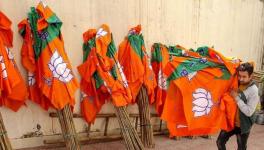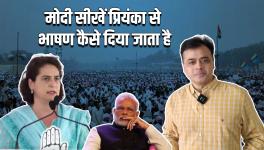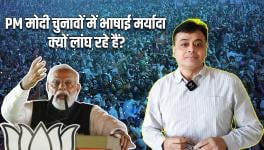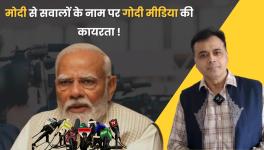INDIA Bloc Looks to Dent BJP Strongholds in Phase 3

Polling for another clutch of Lok Sabha seats will take place today (May 7, 2024) in Phase 3 of the ongoing general elections. Originally slated to have polling in 94 seats, there have been some minor changes. There will be no polling in Surat constituency of Gujarat because the Bharatiya Janata Party (BJP) candidate has been elected unopposed – a rare and rather bizarre happening as the main opposition candidate from Congress had his nomination papers rejected on technical grounds and, curiously, all other candidates withdrew their nominations.
Polling for another seat, Anantnag-Rajouri in Jammu & Kashmir, has been shifted to May 25. Voting for Betul seat from Madhya Pradesh will take place in this round though it was scheduled for the previous round. This is because of the death of a candidate.
Of the 93 seats going to polls in this phase, four in Assam and one in J&K (shifted to May 25) are freshly delimited seats and cannot be compared with the 2019 constituencies. Among the 89 remaining seats, the results of the 2019 elections show an overwhelming dominance of BJP and its allies. The BJP won 70 of them while its allies won another eight, giving their alliance, the National Democratic Alliance or NDA, a total of 78 seats. Among these were all 26 seats from Gujarat, all five seats of eastern Bihar, three out of four seats in northern Chhattisgarh, all 14 seats of northern Karnataka, all nine seats of Madhya Pradesh (and also the additional Betul seat), eight out of 10 seats in central Uttar Pradesh, and one each in West Bengal, Goa and Daman & Diu.
In Maharashtra, Shiv Sena was in alliance with BJP in 2019, and together they won eight out of 11 seats going to polls in phase 3 this time. The lone seat in Dadra and Nagar Haveli was won by an independent in 2019, who passed away leading to a bye-election in 2021, which was won by Shiv Sena. This incumbent MP is now contesting on a BJP ticket.
The opposition INDIA bloc won 10 seats only – two by Trinamool Congress in West Bengal; three by Nationalist Congress Party (NCP), then led by Sharad Pawar in Maharashtra; three by Congress (one each in Chhattisgarh, Goa and West Bengal); and two by Samajwadi Party in UP.
NDA Continues to Falter
The campaign for Phase 3 continued to reveal the increasing degeneration into rank communal appeals by BJP, which is being seen as a sign of desperation. The appeal of “Modi’s Guarantees” has faded into oblivion as has the tomtomming of India’s perceived ‘clout’ in the international arena.
Large sections of people are disillusioned with the policies of the NDA government and sceptical of any promises of ‘Viksit Bharat’ (developed India) and ‘Sabka Sath, Sabka Vishwas, Sabka Vikas”. This disaffection is primarily flowing out of the dire economic situation that common people are faced with – raging and persistent unemployment, stagnant incomes, sustained high prices, difficulties of the MSME (medium, small and micro enterprise) sector, and the ever-widening chasm between the rich and poor.
Added to this are a series of scandals that have emerged, the most shocking one being the allegations of serial sexual offences committed by Prajwal Revanna, son of Janata Dal (S) MP HD Revanna and grandson of former Prime Minister HD Deve Gowda. This Karnataka-based party had recently aligned with BJP and the latter was having high hopes of changing the caste equations in the state with JD(S) as its ally.
Karnataka, in any case, is a state where it would appear that BJP has a difficult task ahead if it wants to repeat last time’s dominant performance, with the party having ingloriously lost the Assembly election last year, and a resurgent Congress aiming to turn the tables in Lok Sabha polls too.
Difficult to Repeat 2019 Results in Hindi Belt
Out of the 31 seats in Hindi-speaking states going to polls in phase 3, BJP had won 28 in 2019. In UP’s 10 seats in the central region, two were won by SP last time, which was in alliance with the Bahujan Samaj Party (BSP), while Congress was fighting separately. This time round, a spirited fight is being put up by the SP-Congress alliance in what is considered a SP stronghold.
While Akhilesh Yadav of SP is trying to woo Dalit communities away from BSP and BJP through his Pichda- Dalit-Alpasankhyak (PDA) alliance of social classes encompassing backward castes, Scheduled Castes and minorities, BJP is hoping to use the Ram Temple magic wand to rally Hindu communities across caste barriers in its support. Evidence from ground reports till now, however, doesn’t show any great effect of this magic wand, although it may serve the purpose of invigorating the party’s listless cadres.
In Bihar, Nitish Kumar’s Janata Dal (United) appears to be a spent force, following its repeated somersaults between the NDA and the INDIA bloc. On the other hand, the Rashtriya Janata Dal (RJD), which is INDIA bloc’s principal component in the state, is poised to garner better support due to its twin strategy of raising economic issues and also criticising BJP’s communal propaganda. The seats going to polls in Bihar in this phase have a considerable Muslim presence and, barring any diversion of votes by Asaduddin Owaisi’s All India Majlis-e- Ittehadul Muslimeen (AIMIM), the INDIA bloc is likely to pose a tough challenge to NDA.
In Chattisgarh and Madhya Pradesh, BJP won 15 out of 16 seats in 2019, with Congress winning a sole seat in Korba, Chhattisgarh. Although substantial hikes in procurement prices of paddy in Chhattisgarh and strong procurement of wheat/paddy in both states may sway farmers, but the weariness of people, including farmers, with distressing economic issues, may crack the otherwise dominant position of BJP in these states.
Maharashtra and Gujarat
Gujarat remains a stronghold of BJP, despite the fact that the people there are discontented with the economic policies of successive BJP governments that have ruled the state since the early nineties. Periodically, this discontent among farmers and working people does break out. However, the systematic suppression of workers’ unions and the cooption of farmers’ leaders has led the movements to dead ends.
Politically, the main opposition remains Congress, which is faction ridden and in disarray. In the 2022 Assembly elections, BJP got nearly 53% votes, while Congress got 27%, and Aam Aadmi Party 12% votes. In the 2019 Lok Sabha elections, BJP got 63% votes in Gujarat while Congress managed just 33%. It is unlikely that in today’s election, any major swing away from BJP in terms of seats will take place, though its vote share is expected to decline.
Maharashtra is the state where BJP in alliance with the Shinde faction of Shiv Sena and the Ajit Pawar faction of the NCP is facing its toughest challenge. The Eknath Shinde-led state government, backed by BJP, is not very popular and BJP is getting considerable criticism for aligning with turncoats. Particularly, its aligning with Ajit Pawar is coming under fire since BJP used to continuously castigate him for corruption when he was in the original NCP, led by his uncle, Sharad Pawar.
In sum, this third round of polling is likely to see a downturn in the NDA tally compared with last time, and will also indicate the direction in which Hindi-belt states are likely to go in the subsequent rounds.
Get the latest reports & analysis with people's perspective on Protests, movements & deep analytical videos, discussions of the current affairs in your Telegram app. Subscribe to NewsClick's Telegram channel & get Real-Time updates on stories, as they get published on our website.
























